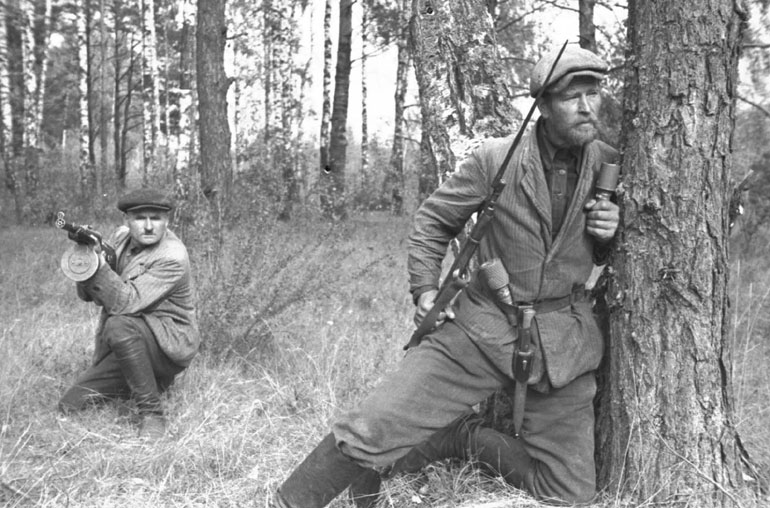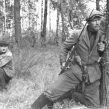
The Partisan Movements in Belarus During World War II (Part One)
Publication: Eurasia Daily Monitor Volume: 12 Issue: 19
By:

Belarus stands out from other European countries in terms of the casualty rates it suffered during World War II: close to one-third of the entire population of Belarus perished in the war. Another distinguishing feature of Belarus is the role played by its underground partisan movement during Nazi Germany’s military occupation, which began on June 22, 1941, and ended in August 1944. Not only is the degree of the locals’ involvement in that movement impressive, but so is the role it continues to play in the historical memory of Belarusians. Therefore, the scope and achievements of the Soviet-directed partisan movement, as well as the role of the partisans in the post-war political elite of Belarus, deserve closer scrutiny.
All of Belarus was occupied by the Germans within two months after June 22, when Adolf Hitler launched the invasion of the Soviet Union. According to the Ministry of Defense of the Republic of Belarus, by the end of 1941, about 12,000 people, grouped into 230 partisan units, were fighting the invaders. By the summer of 1944, the overall number of partisans reached 374,000. There were 1,255 partisan units, 997 of which were subordinated to brigades and others acted on their own. Those were just the Soviet-led detachments, many of which were set up by the pre-war regional administrations. Some partisan groups deployed from beyond the front line. Many units included regular enlisted servicemen who found themselves encircled by the Germans (Mod.mil.by, accessed January 30).
Aside from the Soviet-led guerilla forces most active in eastern Belarus, there were also many Polish partisan units operating in western Belarus. Initially, the activities of Soviet and Polish groups were somewhat coordinated, but after the break in diplomatic relations between the Soviet Union and the Polish government in exile in April 1943, Polish units started being treated as a hostile military force by Soviet-linked units.
The Moscow-led partisan movement quickly became a serious challenge for the German army. And the abundance of dense forests and marshes made it difficult for the Wehrmacht to pursue the insurgents. As early as July 20, 1941, the German Trans-Ocean News Service reported that partisans assaulted the headquarters of the Wehrmacht’s 121st infantry division and killed scores of soldiers and officers, including the division’s commander. Overall, from June 1941 to July 1944, Belarusian partisans assassinated about 500,000 members of the German military and their local collaborators, undermined and derailed 11,128 enemy trains and 34 armored trains, destroyed 29 railway stations and 948 headquarters and garrisons, blasted, burned and destroyed 819 rail and 4,710 other bridges, destroyed more than 7,300 kilometers of phone and telegraph lines, shot down 305 planes, as well as destroyed 1,355 tanks and armored vehicles and 939 military depots. One highlight of the partisan war was the September 22, 1943, assassination of Wilhelm Kube, the leader of the occupation administration of Belarus (Generalkommissar für Weißrussland in Minsk).
The partisan movement of Belarus was coordinated by the Partisan HQ (Tsentralnyi Shtab). From 1942 to 1943, it was headed by Panteleimon Ponomarenko, Soviet Belarus’s Communist leader from 1938 to 1947. The movement’s overall tenacity even resulted in the temporary restoration of Soviet administrations in a number of pockets within the German-occupied area, like in Klichev, Mogilev Oblast (in March 1942), and in 13 villages of Slutsk Rayon, Minsk Oblast (in June 1943).
After the Germans retreated, about 180,000 partisans joined the regular Red Army. On July 16, 1944, at a hippodrome in newly-liberated Minsk, a parade took place in which 30,000 partisans participated.
Some Western authors, notably Jerzy Turonek (in his book, Bialorus pod okupacja niemiecka, Warsaw: Ksiazka i Wiedza, 1993) and Bernhard Chiari (Alltag hinter der Front: Besatzung, Kollaboration und Widerstand in Weißrußland 1941-1944, Dusseldorf: Band 53, 1998) have cited lower estimates of Belarusian war casualties and have downplayed the scope of the Soviet-led partisan movement as well. For example, Turonek claims that the number of civilian casualties in Belarus was about 750,000, less than one-third of the Soviet estimate subsequently cited by post-Soviet Belarusian sources. According to certain historians from the ranks of the Belarusian opposition, partisans in many instances robbed and killed the local peasantry, adding to the burden imposed by the occupiers (Belgazeta, June 3, 2013). Moreover, few people were willing to join the Soviet-led partisan units in western Belarus, where, from September 1939 to June 1941, Stalinist purges affected small entrepreneurs and wealthier peasants (Newsland, May 13, 2010).
Belarus happens to be located on the former Jewish Pale of Settlement, which was set up in the Russian Empire in 1791 and abolished by the Communist Revolution of 1917. Consequently, a separate issue of note, when discussing the partisan movements of World War II, is the growth of Belarusian Jewish partisan units. This issue will be tackled in a subsequent essay.
Pre-war repressions, population exchanges with Poland, and the Holocaust all contributed to critically diminishing the numbers of the traditional political elite—as well as the communities and groups from which they were drawn from—in western Belarus. Moreover, most eastern Belarusian political leaders perished in the war. As a result, surviving Belarusian partisans ended up constituting the core of the post-war political elite of Soviet Belarus. Initially, former partisan leaders born and raised in eastern Belarus were appointed en masse to the regional administrations in all six regions of the Belarusian Soviet republic, while the three first post-war Communist leaders of Belarus—Panteleimon Ponomarenko, Nikolai Gusarov, and Nikolai Patolichev—were Russian-born. However, two subsequent leaders, Kirill Mazurau (1956–1965) and Piotr Masherau (1965–1980) were ethnic Belarusians and former partisan leaders, born in Gomel and Vitebsk Oblasts, respectively. It is under their tutelage that Belarus became an economic success story within the Soviet Union, with the pace of industrial growth and urbanization far exceeding overall Soviet averages. Furthermore, at this point, ethnic Belarusians started making up majorities within their “own” cities for the first time ever. Prior to World War II, Jews, Russians and Poles dominated the nominally Belarusian cities.
That Belarus is a “partisan republic” (respublika-partizanka) is the most well-known aspect of its self-portrait. According to a popular joke, capturing the corridors of power in Minsk became the partisans’ most successful military operation. The day of Minsk’s retaking by the Red Army (July 3, 1944) has become the most important national holiday of newly independent Belarus—the republic’s Independence Day. Starting in the 1970s, the former partisans who were serving at the top echelons of power in Belarus were being gradually replaced by industrial directors—an ever increasing share of whom were born in western Belarus. Still, in modern-day Belarus, the legacy of the partisan movement lives on.




